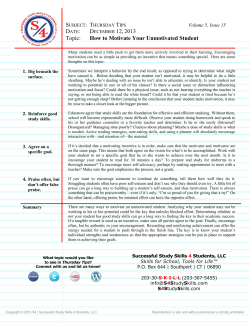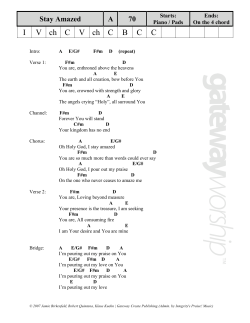
Paraprofessionals… Making a Difference Title 1 Conference April 8, 2011
Paraprofessionals… Making a Difference Title 1 Conference April 8, 2011 Deb Long & Teresa Hurliman Agenda- (strategies may be presented in a different order) • Inspirational Video • Learning Style Survey “Best Practice” Positive Interaction Strategies: Courtesy Communication Equitable Response Opportunities Affirmation & Correction Proximity Individual Help Listening Accepting Feelings Personal Interest and Compliments Praise Behavior Management Bucket Theory • Reflection and Evaluation Norms for the Day • Take care of yourself, take a break when you need to. • Feel free to ask a question or for clarification or an example at any point. Signal if you can’t hear. • Cell phones turned off, please. • Participate, share your ideas, and make a connection with new people. Brain research says how you treat people in the first 10 seconds will determine how well your day goes and will influence how their day goes. So…give a great greeting to your neighbors! Targets • Understand your role in motivating & helping students achieve success. • Understand your style and how it impacts others. • Understand the how and why of building positive relationships with students. …….And have fun! Nine Characteristics of High Performing Schools • Clear and Shared Focus • High Standards and Expectations • High Levels of Collaboration & Communication • Focused Professional Development • Supportive Learning Environment Danielson’s Framework for Teaching Domain 3 • Creating an environment of respect and rapport • Establishing a culture for learning • Managing classroom procedures • Managing student behavior Stand up if you…. Aimee Mullins Igniting the Power in Others TED Talks 2009 • Look at the list of quotes from Aimee Mullins • Find one that resonates with you. • Look around the room, find another person that you don’t know. • Share your quote and tell why you selected it. We need to use our power well and help create new realities and new ways of being for our students. Our goal today is to empower you to empower your students. Knowing Yourself What ‘s your Color Style? What Color Are You? • Read each statement on the Color Styles Inventory. Mark a plus or minus depending on how it describes you. • Add up your + marks to determine your predominant color style: Blue, Orange, Gold, Green. Behavior Management • Objective: To be cool and calm when I redirect or give consequences for student misbehavior. To support the student in developing self management skills. • Student Awareness: “The teacher does not approve of my behavior, but still likes me as a person. I can manage myself.” • Behavior management is like an onion because……………. (Snowball flurry strategy) “No significant learning takes place without a significant relationship.” Dr. James Comer 1+1=2 The key to managing student behavior is to manage your own behavior. Manage Yourself & Manage Your Environment Understanding Motivation Top 2 needs that motivate us: • Safety • Validation and Connection Managing the Environment • You set the stage…You craft the container for student safety and validation. • Space • Organization • Predictable routines • Clear expectations • Pleasant & calm Managing Yourself • Manage Your Beliefs & Attitude • Manage Your Emotions & Behavior • Be Consistent Managing our Beliefs and Attitudes • We need to be Firm and Kind. A Warm Demander. • Learning requires mistakes. They are not little adults. • Student’s need for connection is powerful motivator. Managing our Beliefs and Attitudes Students with challenging behavior haven’t developed ability to self manage. • They need help with: Regulating emotions Developing Relationships Reflecting on their Behavior Managing Your Emotions and Behavior • Develop a Self- Management Plan • Self- Awareness is the first step…What are your triggers? …What bugs you, makes you mad, annoys the heck out you? (fight, flight, or freeze) Self-Management Plan Choose a response that shows you value them & creates safety. • Plug into yourself, check out: What am I upset about? How am I feeling? • Breathe…Exhaling is the key. • Keep your voice calm and neutral. • Think about the other person. What are they upset about? What are they thinking? Self Management Plan con’t • Ask “What do you need?” • Stop talking • Acknowledge the other person before you ask questions or express your point of view. • QTIP • If you can’t get your emotions under control, make a shift, remove yourself, drink water. • Offer student a drink of water or a chance to move or walk. Remember…… Students that are often in most need of our support are the ones that most actively push us away. Maintaining Consistency • To be professional: Your ability to do your best, even when you feel your worst. • Who helps you maintain consistency? • Developing a strong team helps you maintain your positive energy. Always Be Bigger, Stronger, Wiser and Kind Whenever Possible: Follow the Child’s Need Whenever Necessary: Take Charge Marycliff Institute Powell, Hoffman, Cooper “Best Practice” Positive Intervention Strategies • Behavior Management • • • • • • Courtesy Communication Equitable Response Opportunities Affirmation and Correction Proximity Individual Help Listening The Power of Positive • Praise • Accepting Feelings • Personal Interest and Compliments Courtesy Communication Objective: To use courteous words with all students and adults at my school. Student Awareness: “I am respected by the adults at this school.” Do: Courteous words (please , thank you, excuse me) actions and tone, body language & attention to all students. Watch out for: Sarcastic tone, insults, interrupting Equitable Response Opportunities • Objective: Give all students an opportunity to respond and participate. • Student awareness: “I’m going to be called on to perform and participate in this class or group.” • Why are low achieving, minority and female students called on less frequently ? Affirmation and Correction *Objective: Students will receive feedback about their performance. *Student awareness: “I am going to be told promptly whether or not my work is acceptable.” *How do you respond when a student gives a wrong answer? Ways to Respond to an Incorrect Response. • • • • • • • • Look at that again. That’s good, but go further. I never would have thought of that. That’s another way of saying it. Think over your answer again. That’s one answer, can you think of another? You’re working on the right path. Try one more time. Proximity • Objective: In a friendly manner, to be in arm’s reach of students. • Student awareness: “My teacher is close by and it doesn’t bother me.” • What are strategies that you could put into place to increase the use of proximity? Listening • Objective: To listen attentively to all my students. • Student Awareness: “My teacher is really interested in what I have to say.” • Listening Activity: Groups of 6 “Listening is such a simple act. It requires us to be present and that takes practice, but we don’t have to do anything else. We don’t have to advise or coach or sound wise. We just have to be willing to sit there and be present.” Margret Wheatly Individual Help • Objective: To provide individual help to students. • Student Awareness: “My teacher is concerned about me and wants me to succeed.” • Whoever does the work is doing the learning. • I do. We do. You do. “Each time we steal a student’s struggle, we steal the opportunity for them to build self-confidence. They must learn to do hard things to feel good about themselves. Self-confidence comes from being successful at something we perceive as difficult.” Susan Winebrenner The Power of the Positive Praise • Objective: To praise the learning performance of students. • Student awareness: “My teacher is especially pleased with my classwork.” • Other ways to say “Good Job.” Other Ways to Say “Good Job” • Keep it up. • • • • • • • • • Marvelous. Beautiful. Very creative. Good thinking. How impressive. You’re an amazing learner. Nice going. Terrific. Very competent. Accepting Feelings Objective: To convey to all students that their feelings are understood and accepted in a nonjudgmental manner. Student Awareness: “My teacher knows how I feel, and I like that.” Personal Interest and Compliments • Objective: To give personal compliments and express personal interest in students. • Student Awareness: “I am more than just a student to my teacher; my teacher even compliments me.” How Full Is Your Bucket? By Tom Rath and Donald Clifton (An Affirmation, Praise, Personal Interest and Compliments Strategy) The Theory of the Dipper and the Bucket The Bucket • Each of us has an invisible bucket. It is constantly emptied or filled depending on what others say or do to us. When it is full, we feel great. When it is empty we feel awful. We are at our best when our buckets are overflowing; our worst when they are empty. The Dipper • Each of us has an invisible dipper. When we use that dipper to fill each other’s buckets, by saying and doing things to increase their positive emotions, we also fill our own buckets. • Likewise, when we dip from other’s buckets, by saying and doing things that decrease positive emotions, we also empty our own buckets. A full bucket gives us a positive outlook and renewed energy. Every drop in our buckets makes us stronger and more optimistic. But an empty bucket our saps our energy, undermines our will and leads to a negative outlook. Negativity Kills Research from Korean War POWs Self criticism Informing on others Breaking loyalty to leadership and country Withholding all positive and emotional support 38% POW death rate was the highest in U.S. military history 1925 School Study 4th and 6th grade math students’ retention of math concepts over a five day period: Praised – 71% Criticized – 19% Ignored – 5% Why is this important? • More successful relationships. • More productive work and careers • Longer life- lengthen your life by 10 years! • More fun! • We have greater influence and positive effect on our student’s success. Positivity and Productivity The #1 reason people leave their jobs: They don’t feel appreciated. 65% report NO recognition for good work. The need for recognition and validation is our #2 need right after safety. People that got 1 minute of validation at work, increased their work satisfaction by 75%. • We all need full buckets. To increase positive emotions in your life and others’ lives, you must make a habit of filling buckets. • We need to PRAISE = 5:1 positive to negative ratio 5 Ways to Increase Positive Emotions • • • • • Prevent Bucket Dipping Shine a Light on What is Right Make Best Friends Give Unexpectedly Reverse the Golden Rule… Do for others what THEY would like! Give Out Drops You have 20,000 individual moments to give out drops every day… How do I like praise and recognition? • Fill out the Gallup poll survey of 7 questions • Share with a partner Personalize Your Praise for Others Make a conscience plan… “knowing is not enough” • Think of one student and one co-worker • Fill out the grid on each of them • Share at your table Thank you for coming to our session! And thank you for all the work you do on behalf of children everyday. Remember the light at the end of a child’s tunnel, could be you! Reflection and Evaluation • Take a few minutes to reflect on your learning today from “Head to Toe” • Please fill out your conference evaluation and leave both on the table. • Say good-bye and thank your tablemates.
© Copyright 2025
















